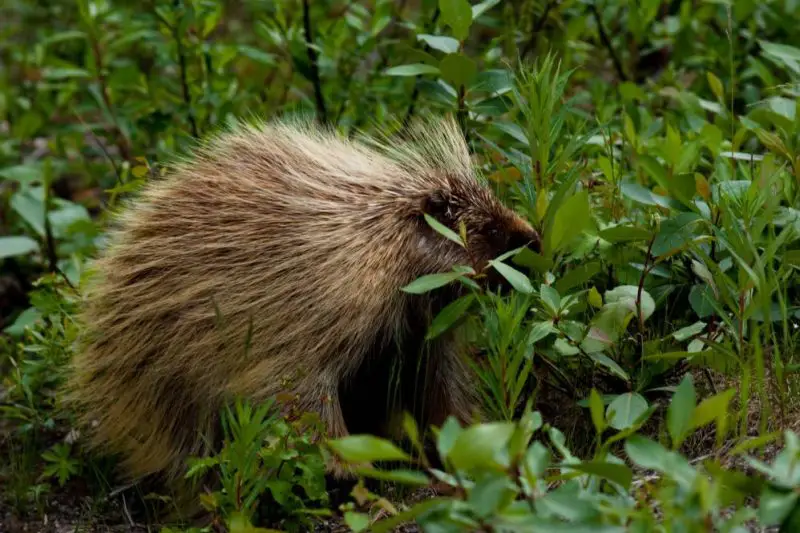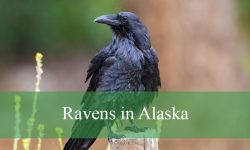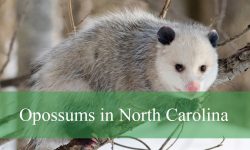When twilight settles over New Hampshire’s forests and the pines whisper in the evening breeze, a quiet figure shuffles through the undergrowth. Its movements are slow but steady, its coat bristling with thousands of quills that shimmer in the fading light. This is the porcupine in New Hampshire — a misunderstood wanderer of the northern woods, solitary yet essential to the forest’s rhythm.
While many know porcupines for their prickly armor, few understand the complexity behind their habits, intelligence, and ecological role. They’re not aggressive villains as myths suggest, but peaceful herbivores who have learned to survive the state’s bitter winters and rugged terrain with patience and precision.
In this in-depth exploration, we uncover the truth about porcupines in New Hampshire — their behavior, biology, diet, and surprising importance to the health of New England’s forests.
Meet New Hampshire’s Porcupine

The North American Porcupine
The species found throughout New Hampshire is the North American porcupine (Erethizon dorsatum), the second-largest rodent in North America after the beaver. Adults weigh between 12 and 35 pounds and can measure up to three feet long, with short legs, rounded bodies, and a distinctive coat covered in quills.
Despite their heavy build, porcupines are adept climbers. Their curved claws and strong tails help them scale trees in search of bark, buds, and leaves. They are also excellent swimmers — buoyed by their hollow quills that trap air and provide natural flotation.
From the granite slopes of the White Mountains to the mixed hardwood forests of the Connecticut River Valley, porcupines in New Hampshire are year-round residents, quietly shaping their ecosystems.
Distinguishing Features
Porcupines are best known for their defensive quills — nearly 30,000 of them, each about two to four inches long. Contrary to popular belief, porcupines cannot shoot quills. Instead, the barbed tips detach easily upon contact, embedding themselves in a predator’s skin.
These quills are marvels of natural engineering. Microscopic barbs make them difficult to remove but also minimize tissue damage upon entry — a biological balance between defense and safety. Combined with dark fur and slow, deliberate movements, the porcupine’s appearance is both unmistakable and symbolic of nature’s quiet resilience.
Habitat and Distribution in New Hampshire
The Perfect Home in the Woods
Porcupines in New Hampshire thrive in mixed coniferous and deciduous forests, where they find abundant sources of food and shelter. They prefer regions with hemlock, pine, birch, and maple — trees that provide bark and twigs through all four seasons.
They often inhabit rocky ledges, hollow logs, or the bases of large trees. In winter, they use dens found in rock crevices or under fallen timber. These dens offer insulation and safety from predators like fishers, coyotes, and bobcats.
Though primarily nocturnal, porcupines can occasionally be spotted during the day basking in sunlight, especially in the chill of early spring.
Range and Population
Porcupines are found statewide — from the forests of Coös County to the Seacoast’s remaining woodlands. Their numbers fluctuate naturally but remain stable thanks to New Hampshire’s vast forest cover and limited natural predators.
In urban fringes, they sometimes wander into orchards or backyards, attracted by fruit trees or wooden structures they like to chew for salt. Their adaptability ensures their continued presence even as landscapes evolve.
The Secret Life of the Porcupine
Nocturnal Wanderers
Porcupines are primarily nocturnal, beginning their foraging just after dusk. Their slow, deliberate pace hides a keen awareness of their surroundings. They use smell and touch to navigate, often following the same foraging routes night after night.
During the day, they rest high in trees or within dens, curling up tightly to conserve warmth. In winter, snow often covers their trails, leaving only small depressions and the occasional quill as clues to their passage.
Their silence and stealth make them one of New Hampshire’s most overlooked forest residents — present yet rarely noticed.
Solitary Yet Socially Intelligent
Though solitary for most of the year, porcupines communicate through scent markings, grunts, and high-pitched vocalizations. During mating season, they interact more frequently, using complex calls that echo through the woods.
Studies reveal that porcupines in New Hampshire possess surprising intelligence. They can navigate mazes, remember food sources, and display curiosity toward new objects. Their measured movements reflect caution, not dullness — a slow rhythm tuned to forest life.
Diet and Feeding Behavior
The Bark-Eating Herbivore
Porcupines are strict herbivores. In spring and summer, they feed on buds, berries, leaves, and herbs. In winter, when food is scarce, they turn to the inner bark and cambium layers of trees like hemlock, pine, and birch.
Using strong incisors, they strip bark cleanly, leaving distinctive chew marks that foresters recognize easily. While their feeding can damage individual trees, it also promotes forest diversity by allowing light and nutrients to reach younger vegetation.
In this way, porcupines in New Hampshire act as natural pruners — shaping forest structure through selective browsing.
A Taste for Salt
One curious behavior of porcupines is their craving for salt. They seek out natural deposits, chew on bones, and sometimes gnaw on wooden tool handles or cabin walls where human sweat has left salty residue.
This taste for salt stems from a mineral deficiency common in their bark-heavy diet. In rural parts of New Hampshire, residents often find porcupine chew marks on outhouses, picnic tables, or plywood — not out of mischief, but biological necessity.
Providing mineral blocks away from structures can help deter this behavior while supporting local wildlife health.
Defenses and Predators
The Quill Strategy
The porcupine’s quills are its primary defense. When threatened, it raises its quills, turns its back to the predator, and lashes its tail. The slightest contact embeds dozens of quills into fur or flesh.
Each quill’s barbed tip expands upon entry, making removal difficult and painful. Most predators learn after a single encounter. However, the fisher — a skilled and fearless predator common in New Hampshire — has evolved methods to attack porcupines by flipping them over to expose their unprotected bellies.
This evolutionary arms race between predator and prey has shaped both species into extraordinary examples of natural adaptation.
Secondary Defenses
Porcupines also rely on scent glands to deter attackers. When agitated, they emit a musky odor as a warning. Their slow movements and cryptic coloring help them blend into forest shadows, avoiding conflict altogether.
Despite popular myths, porcupines do not “throw” quills. Their defensive display is passive — a deterrent rooted in patience and precision, not aggression.
Reproduction and Family Life
Mating Season and Behavior
The breeding season for porcupines in New Hampshire occurs in late summer through early fall. Males compete for access to females using vocal displays and scent marking rather than violent fights.
Courtship is surprisingly gentle. The male approaches cautiously, chattering softly, and may even groom the female before mating — a level of tenderness rare among rodents.
After mating, gestation lasts about seven months, leading to a single birth in spring — usually between April and June.
Raising the Young
Baby porcupines, known as porcupettes, are born fully furred, with soft quills that harden within hours. They can climb within days, following their mother into trees for feeding.
The mother nurses her young for about two months, teaching it to find food and avoid predators. By late summer, the juvenile becomes independent, venturing out to establish its own range.
With their slow reproductive rate — just one offspring per year — porcupines in New Hampshire depend on long lifespans and low predation to sustain stable populations.
Porcupines and New Hampshire’s Ecosystems
The Quiet Foresters
Porcupines play a surprisingly significant role in forest ecology. Their bark-stripping may seem destructive, but it encourages biodiversity by thinning dominant trees and allowing sunlight to reach the forest floor.
By feeding on old or diseased trees, they speed up decomposition and nutrient cycling. Their feeding scars provide entry points for fungi and insects that break down wood, enriching soil and fostering regrowth.
In essence, porcupines in New Hampshire serve as natural foresters, maintaining a cycle of decay and renewal crucial to healthy woodland ecosystems.
Food for the Forest
Though well-defended, porcupines are not immune to predation. Fishers, coyotes, bobcats, and owls occasionally prey upon them. Their carcasses, in turn, feed scavengers and insects, continuing the energy flow through the forest web.
Even in death, porcupines contribute to the vitality of the ecosystem — a reminder that every creature, however small or prickly, plays an irreplaceable role.
Porcupines and Humans in New Hampshire
Encounters in the Wild
Hikers, foresters, and rural homeowners often encounter porcupines in New Hampshire near trails or cabins. Despite their reputation, they are gentle animals that rarely pose a threat. Their quills are purely defensive, used only when cornered or attacked.
To avoid unwanted interactions, maintaining distance and securing food or salt sources is sufficient. Observing one up close — chewing quietly on bark or climbing a pine — is a window into the calm rhythm of forest life.
Porcupines and Forestry
Porcupines occasionally cause localized damage to valuable trees, particularly in timber areas. Their bark feeding can girdle trunks, leading to tree death. However, foresters increasingly view them as part of a natural balance rather than pests.
Selective management — such as maintaining diverse tree species and providing alternate salt sources — minimizes conflicts while preserving ecological benefits.
Through coexistence, both forests and porcupines can thrive side by side.
Myths and Misunderstandings
Do Porcupines Attack?
A common misconception is that porcupines are aggressive or capable of shooting their quills. In reality, they are shy and slow-moving. When threatened, they prefer to climb trees or face away rather than charge.
Their defense is purely reactive — an act of self-preservation, not aggression. Those who mistake caution for hostility simply misread nature’s patience.
Do Quills Kill Predators?
While embedded quills can cause infection or injury, most predators survive initial encounters, learning valuable lessons that keep them away in the future. The system works through deterrence rather than destruction — a model of efficient evolution.
Porcupines are not nature’s killers, but survivors who thrive through peaceful persistence.
Seasonal Adaptations
Surviving New Hampshire Winters
The state’s long, snowy winters demand extraordinary resilience. Porcupines in New Hampshire meet the challenge by growing dense winter coats and shifting diets from soft plants to bark and twigs.
Their metabolic rate drops, conserving energy during the coldest months. They may remain in dens for days during blizzards but do not hibernate. Instead, they rely on stored body fat and steady browsing to survive until spring.
Their endurance in subzero temperatures reflects the quiet strength of northern wildlife.
Summer and Spring Activity
As the snow melts, porcupines become more active, feasting on green vegetation and tender shoots. They travel greater distances in search of food, often venturing near streams and meadows.
Summer also brings increased grooming — an essential habit for removing loose quills and parasites. By autumn, they begin feeding on bark once more, preparing for another New Hampshire winter.
This cycle of adaptation — flexible yet consistent — defines their survival across the seasons.
Surprising and Little-Known Facts About Porcupines in New Hampshire
-
Each porcupine carries about 30,000 quills, replaced gradually throughout its life.
-
Quills contain antibiotics, reducing infection risk if they pierce the porcupine’s own skin.
-
Porcupines use tree scent marking to signal territory.
-
They can climb over 50 feet high to reach tender branches.
-
Their closest relatives are beavers, not hedgehogs.
-
Porcupines have excellent hearing but poor eyesight.
-
Fishers are their only significant predator capable of consistent kills.
-
Their front teeth grow continuously, worn down by constant gnawing.
-
They can live up to 10 years in the wild.
-
Their name comes from the Latin porcus spina — “spiny pig.”
FAQs About Porcupines in New Hampshire
Do porcupines hibernate?
No, they remain active year-round, though they move less in deep winter.
Are porcupines dangerous to pets?
Only if a dog or cat tries to attack them. Quills can injure but are not venomous.
What do porcupines eat most in New Hampshire?
Tree bark, buds, and leaves — especially hemlock, maple, and birch.
How can I protect wooden structures from porcupines?
Use metal flashing or provide salt blocks away from buildings to divert them.
Where are porcupines found in New Hampshire?
Across the state, especially in mixed forests and rocky ridges.
Are porcupines good for the environment?
Yes. They help regenerate forests and support diverse ecosystems.
How many babies do porcupines have?
Usually one per year — a single porcupette born each spring.
Do porcupines make sounds?
Yes, they grunt, whine, and even “sing” softly during mating season.
Can porcupines climb trees?
Absolutely. They are expert climbers using claws and tails for grip.
How long do porcupines live?
Typically 5–10 years in the wild, depending on predators and habitat.
Final Thoughts
The porcupines of New Hampshire are more than prickly forest dwellers — they are quiet architects of the wilderness, shaping forests, dispersing nutrients, and teaching balance through their steady presence.
Misunderstood and often maligned, these gentle herbivores embody a wisdom rooted in patience. They move slowly but live purposefully, leaving behind a healthier forest for generations of life to follow.
So, the next time you walk through New Hampshire’s woods and notice stripped bark or quill tracks in the snow, remember — you’re witnessing the quiet work of one of nature’s most fascinating engineers.
The truth about porcupines in New Hampshire is simple yet profound: they are guardians of the forest’s rhythm, prickly on the outside but vital to the wild heart within.






